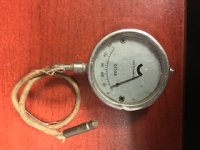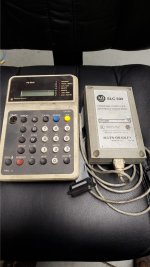You are using an out of date browser. It may not display this or other websites correctly.
You should upgrade or use an alternative browser.
You should upgrade or use an alternative browser.
So Cool!
- Thread starter PLC Pie Guy
- Start date
JRW
Member
That’s very cool!
Steve Bailey
Lifetime Supporting Member + Moderator
The probe looks like a phone jack. Is it insulated?
danw
Lifetime Supporting Member
Is the reference connection the pointy thing at 6 0'clock, at the bottom of the housing?
PLC Pie Guy
Member
OP
Yes to both questions.
Steve Bailey
Lifetime Supporting Member + Moderator
Fifty volts doesn't seem like enough range, but could it be a static detector?
PLC Pie Guy
Member
OP
I was thinking a battery checker maybe.
????
????
PLC Pie Guy
Member
OP
I tried it on 24VDC but it doesn't seem to work. The needle doesn't move.
Maybe I need to RTFM!
Maybe I need to RTFM!
GaryS
Member
it looks like a meter to check the old telephone switch boards
plug it in and measure the voltage
The old landline phones had 48 volts DC on the line to power the phone
that meter reads up to 50 volts they used a 1/4" 2 pole jack in those days
plug it in and measure the voltage
The old landline phones had 48 volts DC on the line to power the phone
that meter reads up to 50 volts they used a 1/4" 2 pole jack in those days
circa 1920/1930?...
These antique pocket-watch-style electric meters were known as battery testers
...The DC voltmeters and DC ammeters contain copper-wire moving coils, some with jewelled movements, and many are encased in bakelite or metal, which is typically nickel-plated. These portable meters were primarily used to check A, B, and/or C type dry-cell carbon batteries for vacuum tube radio receivers and other electrical apparatus during the time period.
...
Pocket Battery Testing Meters
In the days when having a valve "wireless" meant periodically purchasing an expensive High Tension battery and regularly taking your 2 Volt lead acid accumulator to the local radio shop or garage for recharging, it was necessary for the owner to have a means of establishing if the poor performance of the radio was due to "flat" battery or something more serious. These were widely used in the 1920's and 1930's.
...
Pocket watch style Voltmeters were first used in the 1880/90s but became widespread during the 1920/30s with most having a brass case that was typically nickel plated though Bakelite examples are known. The case was normally connected to the negative connection, an arrangement that caused numerous electric shocks especially when the rubber insulation within failed. These little testers were used for many tasks but they were designed to be used by Radio Engineer's for measuring the "plate" (anode) voltage of thermionic valves in radios and their grid voltages. The insulated wire that came from the top of the meter was touched onto the negative terminal while the spike/foot was placed on the positive terminal and the reading would be taken from the scale.
Very nice piece, PLC Pie Guy. Even though some of these are around 100 years old, they're not worth a whole lot though. Probably about 25-50 Earth Credits, depending on condition?
Regards,
George
These antique pocket-watch-style electric meters were known as battery testers
...The DC voltmeters and DC ammeters contain copper-wire moving coils, some with jewelled movements, and many are encased in bakelite or metal, which is typically nickel-plated. These portable meters were primarily used to check A, B, and/or C type dry-cell carbon batteries for vacuum tube radio receivers and other electrical apparatus during the time period.
...
Pocket Battery Testing Meters
In the days when having a valve "wireless" meant periodically purchasing an expensive High Tension battery and regularly taking your 2 Volt lead acid accumulator to the local radio shop or garage for recharging, it was necessary for the owner to have a means of establishing if the poor performance of the radio was due to "flat" battery or something more serious. These were widely used in the 1920's and 1930's.
...
Pocket watch style Voltmeters were first used in the 1880/90s but became widespread during the 1920/30s with most having a brass case that was typically nickel plated though Bakelite examples are known. The case was normally connected to the negative connection, an arrangement that caused numerous electric shocks especially when the rubber insulation within failed. These little testers were used for many tasks but they were designed to be used by Radio Engineer's for measuring the "plate" (anode) voltage of thermionic valves in radios and their grid voltages. The insulated wire that came from the top of the meter was touched onto the negative terminal while the spike/foot was placed on the positive terminal and the reading would be taken from the scale.
Very nice piece, PLC Pie Guy. Even though some of these are around 100 years old, they're not worth a whole lot though. Probably about 25-50 Earth Credits, depending on condition?
Regards,
George
PLC Pie Guy
Member
OP
These antique pocket-watch-style electric meters were known as battery testers
...The DC voltmeters and DC ammeters contain copper-wire moving coils, some with jewelled movements, and many are encased in bakelite or metal, which is typically nickel-plated. These portable meters were primarily used to check A, B, and/or C type dry-cell carbon batteries for vacuum tube radio receivers and other electrical apparatus during the time period.
...
Pocket Battery Testing Meters
In the days when having a valve "wireless" meant periodically purchasing an expensive High Tension battery and regularly taking your 2 Volt lead acid accumulator to the local radio shop or garage for recharging, it was necessary for the owner to have a means of establishing if the poor performance of the radio was due to "flat" battery or something more serious. These were widely used in the 1920's and 1930's.
...
Pocket watch style Voltmeters were first used in the 1880/90s but became widespread during the 1920/30s with most having a brass case that was typically nickel plated though Bakelite examples are known. The case was normally connected to the negative connection, an arrangement that caused numerous electric shocks especially when the rubber insulation within failed. These little testers were used for many tasks but they were designed to be used by Radio Engineer's for measuring the "plate" (anode) voltage of thermionic valves in radios and their grid voltages. The insulated wire that came from the top of the meter was touched onto the negative terminal while the spike/foot was placed on the positive terminal and the reading would be taken from the scale.
Very nice piece, PLC Pie Guy. Even though some of these are around 100 years old, they're not worth a whole lot though. Probably about 25-50 Earth Credits, depending on condition?
Regards,
George
Wow.
Great history lesson!
geniusintraining
Lifetime Supporting Member + Moderator
Even though some of these are around 100 years old, they're not worth a whole lot though. Probably about 25-50 Earth Credits, depending on condition?
1 Earth Credit = 1 USD
pocket voltmeter vintage search on fleebay https://www.ebay.com/sch/i.html?_fr...c=0&_sop=16&_osacat=0&_odkw=pocket+volt+meter
geniusintraining said:1 Earth Credit = 1 USD
Yes Mark, because we all know the U.S. is the "base" measurement for everything on the planet
drbitboy
Lifetime Supporting Member
Yes Mark, because we all know the U.S. is the "base" measurement for everything on the planet
Base? Did you say "base?"
That can be take two ways.
But you only meant it one way ...
Similar Topics
I have been playing w/ my Microsoft 365 account.
Found this as I was looking for Visio.
Apparently there is this form app.
I just started one...
- Replies
- 2
- Views
- 1,061
I'm a big fan of aliasing I/O channels to P&ID device names, but with all the new built-in I/O features, how are the cool kids aliasing?
The...
- Replies
- 8
- Views
- 3,601
- Replies
- 5
- Views
- 1,697
Heat/Cool – First Experience
Although we have extensive PID heating experience for thermoplastic injection molding, today we are faced with a...
- Replies
- 6
- Views
- 2,057
Launch and came back, nice programming :)
http://www.spacex.com/webcast
- Replies
- 60
- Views
- 38,530






